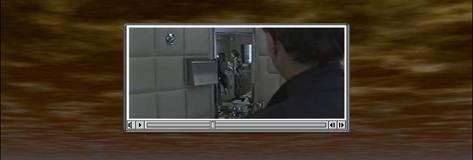
Ursula Hentschlaeger
Zelko Wiener
Vice Versa. Mediatised
Projections in the Worlds of Science-Fiction Movies
1998
This work aimed at focusing on a
mediatised notion of the mirror, which can mainly be defined on
the basis of distinctions: If, in visions of the future, the
traditional mirror still serves as
1. an
instrument of observation, self-knowledge and exposure, and
2. as a means
to condense interior worlds and dream worlds then the
"new" ways of mirroring, which are eventally always
mediatised project-ions, find their equivalents in
3. digital
instruments (of control) or as
4.
constructions of reality in a fictitious cyberspace.
BACKGROUND
OBSERVATION
2. Projections as instruments of deception:
The reflection of "interior"
images
Reflections of the "interior"
and the depiction of dreams are bulwarks of poetic license in
cinematic history. They are not dependent on claims of showing
reality and often seem akin to literature. Interior images can
take the shape of gruesome nightmares, as is the case in Event
Horizon (where peoples' weaknesses are used to drive them out
of their minds) or in Star Trek (where awaking from one dream
leads on to the next one). They may also reflect longings, as
in Contact (where the astronaut ventures into space to land in
her own childhood) or in E.T. (where a boy wishes to be closely
connected to his new friend – why not by telepathy?). The
closing sequence of 2001 – A Space Odyssey (in which the
astronaut can see himself in rapid succession as an old man, a
new-born baby and as the man he actually is) finally reflects a
whole life in quick motion.
INTRERIORWORLD
CONTROL
CONSTRUCTION
CONCLUSION





